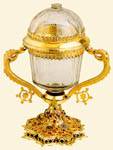|
|
| Byzantine Minor Arts |
ca. 1400 Vatopedi Monastery Height 25 cm |
|

|
This reliquary is a typical example of silver and rock crystal Venetian work. The narrow length-wise facetting of the deep cylindrical cup with the hemispherical lid reflect the precious material of which it is made. The silver-gilt mount consists of a tall foot on an octagonal base, a pair of dragon-shaped handles, and a fillet of acanthus leaves around the rims of both cup and lid. The finial ornament is missing from the top of the lid. The most striking feature of the decoration, which covers the foot like a flora mesh, is the separate over-layer of spiralling shoots with vine leaves, still retaining traces of enamel, surmounting the underlying scroll of foliage. Reliquaries with similar mounts occur in churches in Stara Boleslav and Duesseldorf, and have been dated to the first half of the fourteenth century (Hahnloser 1971, pp. 133-4, 148-9, pl. CXXXI. Fillitz - Morello 1994, nos. 88, 90). This type of work is considered an offshoot of the opus venetum ad filum, and in older, thirteenth-century, pieces, the shoots, usually made of metal sheet, are combined with figures of animals (Hahnloser 1971, no. 148, pls. CXXX-CXXXI. Fillitz - Morello 1994, no. 87), while in the fourteenth century the emphasis is on flora motifs. This tendency appears to follow developments in Venetian silver-work, as displayed in the work of the 'master of serpentine' (1325-50), characteristic of which are the large inlaid vine leaves with stems that twist into loops (Trιsor de Saint-Marc 1984, nos. 41-2. Fillitz - Morello 1994, no. 104). The parallel is particularly clear in the dragon-handles of the Vatopedian reliquary, which are ornamented with similar leaves around which loop tendrils with tightly curled shoots. This type of mount seems to have continued to be used until the fifteenth century. The acanthus leaves are found in works from the second half of the fourteenth century, and a pair of reliquaries with composite dragon handles, from the treasure of the Medici, have been dated to the late fourteenth or early fifteenth century (Massinelli - Tuena 1992, pp. 50, 52-3. Fillitz - Morello 1994, nos. 97-8, 106). The circular seal of San Marco (not used in the 14th century) and the silversmith's hallmark both confirm that this is an early fifteenth-century work (Pazzi 1992, nos. 240, 594). A crystal vessel occasionally described as kratetera is mentioned in the Vatopedi Monastery's lists of sacred vessels, in pilgrim's books and in the patria - that is, in the monastery's short chronicles - and is held to be a gift from Andronicos Palaeologos. This tradition, which probably refers to the Despot of Thessaloniki (1408-23), seems to have arisen in the sixteenth century. The description of the reliquary as a 'handled cup' is interesting, and presumably retains the rarely encountered sense of an ecclesiastical vessel hold by its handles.
| |
|
Bibliography: Ballian 1996, pp. 500-3.
| ||
| A. B. | ||
| Index of exhibits of Monastery of Vatopedi 15th century |
||
Reference address : https://www.elpenor.org/athos/en/e218ci33.asp